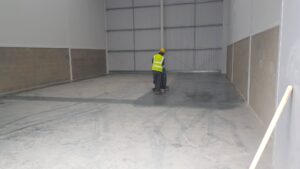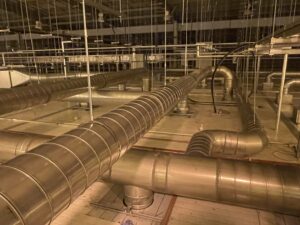Maintaining a clean floor in a distribution and logistics hub is not simply a matter of aesthetics — it’s an essential aspect of operational efficiency, safety, legal compliance, and even business reputation. With thousands of square metres of space, heavy machinery in constant motion, and a high throughput of goods, floor cleanliness directly influences the productivity and safety of any warehousing or logistics environment, so warehouse floor cleaning is important.
Why Floor Cleanliness Matters
1. Health and Safety Compliance
The Health and Safety at Work etc. Act 1974 is the cornerstone of workplace safety in the UK. Under this legislation, employers are legally obliged to ensure a safe working environment for all staff, including maintaining floors free from hazards such as spillages, debris, or obstructions. Additionally, the Workplace (Health, Safety and Welfare) Regulations 1992 specifically mandate that floors in workplaces “shall be suitable, in good condition and free from obstructions”.
Poor floor hygiene can lead to:
- Slips, trips and falls – which accounted for 30% of all non-fatal workplace injuries in 2022/23, according to the Health and Safety Executive (HSE).
- Forklift accidents due to skidding or poor traction.
- Health issues related to dust and allergens in the air.
2. Operational Efficiency
In a logistics hub, speed and precision are critical. Clean floors allow for smoother operation of materials handling equipment (MHE) such as forklifts, automated guided vehicles (AGVs), and pallet trucks. Debris or oil spillages can cause vehicles to malfunction or slow down, reducing overall efficiency.
According to a 2021 study published in the Journal of Logistics and Transport, facilities with routine floor cleaning protocols had a 23% higher throughput efficiency compared to those with inconsistent or poor floor hygiene.
3. Minimising Equipment Wear and Tear
Dust, grit, and other foreign materials can contribute to premature wear of tyres, bearings, conveyor systems, and other mechanical components. A clean floor reduces the number of contaminants entering machinery, prolonging equipment lifespan and lowering maintenance costs.
In a report by the Chartered Institute of Logistics and Transport (CILT), equipment operating in clean environments required 18% fewer repairs annually than those in dust-heavy or unclean settings.
4. Enhancing Employee Morale and Satisfaction
A clean and well-maintained workplace signals to employees that their health and well-being are valued. It creates a more pleasant and safer environment, which can boost morale, productivity, and job satisfaction.
The British Institute of Facilities Management (BIFM) states that cleanliness in the workplace can have a direct psychological impact on employees, often influencing their perception of their employer and their own professional standards.
Relevant UK Legislation
Maintaining clean floors isn’t just good practice — it’s a legal requirement. Key pieces of UK legislation include:
- The Health and Safety at Work etc. Act 1974: Obligates employers to ensure the health, safety, and welfare of employees.
- The Workplace (Health, Safety and Welfare) Regulations 1992: Includes specific clauses on the condition and cleanliness of floors.
- The Management of Health and Safety at Work Regulations 1999: Requires risk assessments, which must consider slips, trips, and cleanliness hazards.
- The Control of Substances Hazardous to Health (COSHH) Regulations 2002: Relevant if dust, chemicals, or waste products pose health risks.
Non-compliance with these regulations can result in legal penalties, fines, or even criminal prosecution.
Cost of Poor Floor Maintenance
A failure to maintain clean floors can be financially devastating. Here’s how:
- Workplace Injuries: Slips, trips, and falls cost UK businesses over £500 million annually in lost productivity, compensation, and fines (HSE, 2023).
- Legal Liability: Companies can face substantial legal costs following workplace injury claims.
- Downtime: Cleaning up after an incident or repairing damaged equipment leads to avoidable downtime.
- Reputation Damage: Clients and stakeholders expect professionalism; dirty or unsafe warehouses can harm business relationships.
Key Areas of Focus in Floor Cleaning for Logistics Hubs
While entire facilities must be kept clean, specific attention should be paid to:
- Loading Bays: These high-traffic areas are prone to oil, tyre marks, and debris.
- Aisles and Picking Zones: Critical for safety and speed; even minor obstructions can cause delays or injuries.
- Automated Systems: Conveyor belts and robotic paths must be clean to function efficiently.
- Chill and Cold Stores: Require specialist cleaning to prevent condensation-related slips and mould buildup.
Best Practices for Floor Cleaning
To ensure consistent and effective floor cleanliness, logistics operators should adopt structured practices:
- Scheduled Cleaning: Daily and weekly cleaning schedules reduce the build-up of dirt and contaminants.
- Mechanical Sweepers and Scrubbers: These machines provide efficient deep cleaning for large surfaces.
- Spill Response Kits: Readily available kits for oil, chemical, or liquid spills reduce hazard time.
- Trained Staff: Staff should be trained to recognise and address cleanliness issues, not just custodial teams.
Top 10 Tips for Maintaining Clean Floors in Logistics Hubs
- Conduct Regular Risk Assessments – Identify floor hazards and update cleaning protocols accordingly.
- Implement Zoning Systems – Separate clean and dirty zones to reduce cross-contamination.
- Use High-Quality Floor Sealants – Prevent dirt ingress and make floors easier to clean.
- Automate Where Possible – Use floor-cleaning robots for consistent performance in large areas.
- Regularly Inspect MHE Tyres – Dirty or damaged tyres can spread debris.
- Invest in Staff Training – Encourage a cleanliness-first culture.
- Maintain Drainage Systems – Especially important in areas where liquids are handled.
- Monitor Air Quality – Airborne dust settles on floors; filtering the air helps reduce floor cleaning requirements.
- Choose the Right Cleaning Chemicals – Especially important for food or pharmaceutical distribution hubs.
- Track Cleaning Performance – Use KPIs and audits to ensure standards are maintained.
SEO Benefits of Clean Floor Standards in Logistics
From a digital marketing perspective, highlighting a commitment to clean, safe, and efficient operations can significantly improve a logistics company’s online reputation. Search engine algorithms favour content that promotes trust and authority — and workplace safety is a key trust factor for B2B customers.
Including keywords such as:
- “warehouse floor cleaning safety”
- “logistics health and safety compliance”
- “distribution hub maintenance best practices”
- “HSE floor regulations for warehouses”
…can improve visibility in search results, particularly when supported by case studies, testimonials, and certifications.
Conclusion
A clean floor in a logistics and distribution hub is more than just a hygiene requirement — it’s a business imperative. With serious implications for safety, efficiency, compliance, and even brand image, investing in floor maintenance pays significant dividends in both tangible and intangible ways. As logistics becomes ever more automated and customer expectations grow, cleanliness will be a key differentiator in performance and professionalism. By understanding the legal framework, financial implications, and best practices involved, businesses can ensure that their operations are not just clean — but smart, safe, and future-ready.






